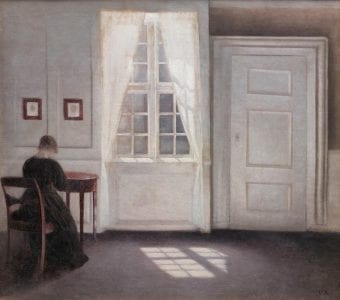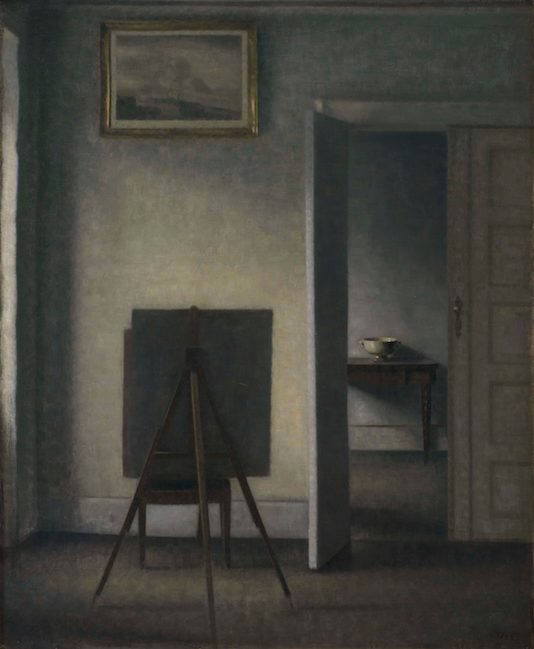Painting Tranquility: Masterworks by Vilhelm Hammershøi from SMK is curated by Kasper Monrad, Chief Curator at SMK – The National Gallery of Denmark, and organized by SMK, and is currently on display at Scandinavia House in Manhattan. The exhibition presents a wide selection of masterpieces by Danish painter Vilhelm Hammershøi (1864-1916), commonly referred to as “de stillestuers maler” (the painter of tranquil rooms). But ‘tranquility’ appears to be a vast understatement for what Hammershøi is achieving in these muted tableaus. The curatorial organization of his paintings into three rooms—reduced landscapes and unpopulated urban cityscapes, portraits, and spare, sunlight-infused interiors—are unilaterally joined by the eerie space they occupy: as stillness approaches absence.

This particular vacancy can only be produced through the passage of time and experience of resonating light, air and sound—even love. The morning light diffraction, the nape of his wife’s neck, a door ajar, all become symbols of Hammershøi’s sense of home, emotionally, and physically. His wife and sister are part of the architecture of this contentment. With each displacement of these subjects into different paintings, desire and significance is recapitulated. The surface of the canvases are blurry, as if we haven’t yet completely woken, causing one to squint with a soft focus, yet the window panes and light hitting the floor is rendered with a sharply linear contours. The seemingly mundane becomes ethereal. In these interior spaces, the figures are more like occupants, occupying a space, no differently than a vessel on a dinner table. This is not to undermine their importance, but rather to propose the dissolution of an object or person into an ambient feeling. Perhaps this is why the painter’s austere rooms inspired the film sets for “The Danish Girl.” As Hammershøi commented in 1907 on the subject of painting vacant rooms, “I have always thought there was such beauty about a room like that, even though there weren’t any people in it, perhaps precisely when there weren’t any.” (The Poetry of Silence, exh. cat. Royal Academy of Arts, London, 2008).

Not unlike Giorgio Morandi’s objects, these interior paintings demand close looking until one finds themselves “seeing solid in void and void in solid” (Bryson 1990: 98). Hammershøi’s seventeenth-century merchant house home at Strandgade 30 in Copenhagen inspired many of the paintings in this exhibition, rendering its image in early morning, noon, and at night. In “Interior with the Artist’s Easel,” Hammershøi uses architectonics to bind the atomized and muffled surfaces of his domestic interiors, without which they are obliquely modern blocks of color. The canvas faced away from the viewer presumably depicts the room we occupy, the painting hanging above the door’s lintel does not attempt any illusory tricks, and both are triangulated by an open door which serves to frame another interior in anticipation of another painting. The echo of nuanced light upon surfaces, disarticulated walls, hardwood floors, empty hallways are graciously articulated in Hammershøi’s interiors; they demand contemplation and reevaluation of the genre’s quiet but earnest contribution.
Painting Tranquillity: Masterworks by Vilhelm Hammershoi from SMK – The National Gallery of Denmark, runs through March 26 at Scandinavia House, 58 Park Ave., Manhattan; 212-779-3587.
